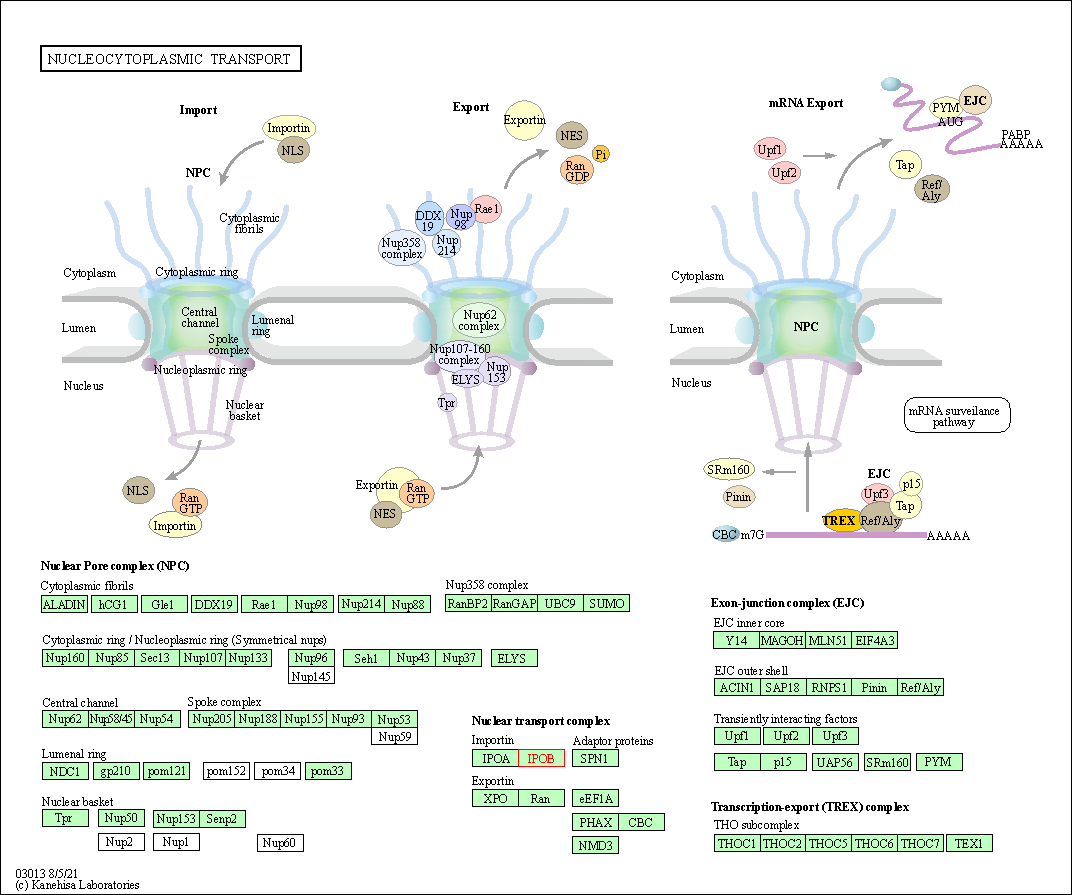Target Information
| Target General Information | Top | |||||
|---|---|---|---|---|---|---|
| Target ID |
T64022
(Former ID: TTDI02102)
|
|||||
| Target Name |
Importin beta (KPNB1)
|
|||||
| Synonyms |
Pore targeting complex 97 kDa subunit; PTAC97; Nuclear factor p97; NTF97; Karyopherin subunit beta1; Karyopherin subunit beta-1; Importin90; Importin-90; Importin subunit beta1; Importin subunit beta-1
Click to Show/Hide
|
|||||
| Gene Name |
KPNB1
|
|||||
| Target Type |
Literature-reported target
|
[1] | ||||
| Function |
Acting autonomously, serves itself as NLS receptor. Docking of the importin/substrate complex to the nuclear pore complex (NPC) is mediated by KPNB1 through binding to nucleoporin FxFG repeats and the complex is subsequently translocated through the pore by an energy requiring, Ran-dependent mechanism. At the nucleoplasmic side of the NPC, Ran binds to importin-beta and the three components separate and importin-alpha and -beta are re-exported from the nucleus to the cytoplasm where GTP hydrolysis releases Ran from importin. The directionality of nuclear import is thought to be conferred by an asymmetric distribution of the GTP- and GDP-bound forms of Ran between the cytoplasm and nucleus. Mediates autonomously the nuclear import of ribosomal proteins RPL23A, RPS7 and RPL5. Binds to a beta-like import receptor binding (BIB) domain of RPL23A. In association with IPO7 mediates the nuclear import of H1 histone. In vitro, mediates nuclear import of H2A, H2B, H3 and H4 histones. In case of HIV-1 infection, binds and mediates the nuclear import of HIV-1 Rev. Imports SNAI1 and PRKCI into the nucleus. Functions in nuclear protein import, either in association with an adapter protein, like an importin-alpha subunit, which binds to nuclear localization signals (NLS) in cargo substrates, or by acting as autonomous nuclear transport receptor.
Click to Show/Hide
|
|||||
| BioChemical Class |
Eukaryotic nuclear pore complex
|
|||||
| UniProt ID | ||||||
| Sequence |
MELITILEKTVSPDRLELEAAQKFLERAAVENLPTFLVELSRVLANPGNSQVARVAAGLQ
IKNSLTSKDPDIKAQYQQRWLAIDANARREVKNYVLQTLGTETYRPSSASQCVAGIACAE IPVNQWPELIPQLVANVTNPNSTEHMKESTLEAIGYICQDIDPEQLQDKSNEILTAIIQG MRKEEPSNNVKLAATNALLNSLEFTKANFDKESERHFIMQVVCEATQCPDTRVRVAALQN LVKIMSLYYQYMETYMGPALFAITIEAMKSDIDEVALQGIEFWSNVCDEEMDLAIEASEA AEQGRPPEHTSKFYAKGALQYLVPILTQTLTKQDENDDDDDWNPCKAAGVCLMLLATCCE DDIVPHVLPFIKEHIKNPDWRYRDAAVMAFGCILEGPEPSQLKPLVIQAMPTLIELMKDP SVVVRDTAAWTVGRICELLPEAAINDVYLAPLLQCLIEGLSAEPRVASNVCWAFSSLAEA AYEAADVADDQEEPATYCLSSSFELIVQKLLETTDRPDGHQNNLRSSAYESLMEIVKNSA KDCYPAVQKTTLVIMERLQQVLQMESHIQSTSDRIQFNDLQSLLCATLQNVLRKVQHQDA LQISDVVMASLLRMFQSTAGSGGVQEDALMAVSTLVEVLGGEFLKYMEAFKPFLGIGLKN YAEYQVCLAAVGLVGDLCRALQSNIIPFCDEVMQLLLENLGNENVHRSVKPQILSVFGDI ALAIGGEFKKYLEVVLNTLQQASQAQVDKSDYDMVDYLNELRESCLEAYTGIVQGLKGDQ ENVHPDVMLVQPRVEFILSFIDHIAGDEDHTDGVVACAAGLIGDLCTAFGKDVLKLVEAR PMIHELLTEGRRSKTNKAKTLATWATKELRKLKNQA Click to Show/Hide
|
|||||
| 3D Structure | Click to Show 3D Structure of This Target | PDB | ||||
| Cell-based Target Expression Variations | Top | |||||
|---|---|---|---|---|---|---|
| Cell-based Target Expression Variations | ||||||
| Different Human System Profiles of Target | Top |
|---|---|
|
Human Similarity Proteins
of target is determined by comparing the sequence similarity of all human proteins with the target based on BLAST. The similarity proteins for a target are defined as the proteins with E-value < 0.005 and outside the protein families of the target.
A target that has fewer human similarity proteins outside its family is commonly regarded to possess a greater capacity to avoid undesired interactions and thus increase the possibility of finding successful drugs
(Brief Bioinform, 21: 649-662, 2020).
Human Tissue Distribution
of target is determined from a proteomics study that quantified more than 12,000 genes across 32 normal human tissues. Tissue Specificity (TS) score was used to define the enrichment of target across tissues.
The distribution of targets among different tissues or organs need to be taken into consideration when assessing the target druggability, as it is generally accepted that the wider the target distribution, the greater the concern over potential adverse effects
(Nat Rev Drug Discov, 20: 64-81, 2021).
Human Pathway Affiliation
of target is determined by the life-essential pathways provided on KEGG database. The target-affiliated pathways were defined based on the following two criteria (a) the pathways of the studied target should be life-essential for both healthy individuals and patients, and (b) the studied target should occupy an upstream position in the pathways and therefore had the ability to regulate biological function.
Targets involved in a fewer pathways have greater likelihood to be successfully developed, while those associated with more human pathways increase the chance of undesirable interferences with other human processes
(Pharmacol Rev, 58: 259-279, 2006).
Biological Network Descriptors
of target is determined based on a human protein-protein interactions (PPI) network consisting of 9,309 proteins and 52,713 PPIs, which were with a high confidence score of ≥ 0.95 collected from STRING database.
The network properties of targets based on protein-protein interactions (PPIs) have been widely adopted for the assessment of target’s druggability. Proteins with high node degree tend to have a high impact on network function through multiple interactions, while proteins with high betweenness centrality are regarded to be central for communication in interaction networks and regulate the flow of signaling information
(Front Pharmacol, 9, 1245, 2018;
Curr Opin Struct Biol. 44:134-142, 2017).
Human Similarity Proteins
Human Tissue Distribution
Human Pathway Affiliation
Biological Network Descriptors
|
|
|
Note:
If a protein has TS (tissue specficity) scores at least in one tissue >= 2.5, this protein is called tissue-enriched (including tissue-enriched-but-not-specific and tissue-specific). In the plots, the vertical lines are at thresholds 2.5 and 4.
|

| KEGG Pathway | Pathway ID | Affiliated Target | Pathway Map |
|---|---|---|---|
| Nucleocytoplasmic transport | hsa03013 | Affiliated Target |

|
| Class: Genetic Information Processing => Translation | Pathway Hierarchy | ||
| Degree | 29 | Degree centrality | 3.12E-03 | Betweenness centrality | 1.01E-03 |
|---|---|---|---|---|---|
| Closeness centrality | 2.13E-01 | Radiality | 1.37E+01 | Clustering coefficient | 2.34E-01 |
| Neighborhood connectivity | 1.53E+01 | Topological coefficient | 1.18E-01 | Eccentricity | 12 |
| Download | Click to Download the Full PPI Network of This Target | ||||
| Target Regulators | Top | |||||
|---|---|---|---|---|---|---|
| Target-regulating microRNAs | ||||||
| Target-interacting Proteins | ||||||
| References | Top | |||||
|---|---|---|---|---|---|---|
| REF 1 | Identification of KPNB1 as a Cellular Target of Aminothiazole Derivatives with Anticancer Activity. ChemMedChem. 2016 Jul 5;11(13):1406-9. | |||||
If You Find Any Error in Data or Bug in Web Service, Please Kindly Report It to Dr. Zhou and Dr. Zhang.

